Keeping fish is an incredibly popular pastime in the U.S., according to the National Pet Owners Survey 2019-2020, and there’s no doubt that a beautifully aquascaped aquarium makes a stunning focal point in any room in your house.
But fish tanks are heavy, awkward things to move, so it’s critical that you choose the correct place for your fish tank location from the get-go. So, what is a good place to put your tank?
Ideally, your fish tank should be placed on a custom-made stand, not a piece of standard household furniture, out of direct sunlight, away from heat sources and drafts, and close to power points so that you can plug in items like tank filters, heaters, and lighting units.
Keep the tank clear of doorways and places where pets and kids could bump into it, and ensure the flooring on which the aquarium sits is strong enough to take the weight.
Keep reading to learn more about the perfect place to site your fish tank!
Selecting The Right Tank
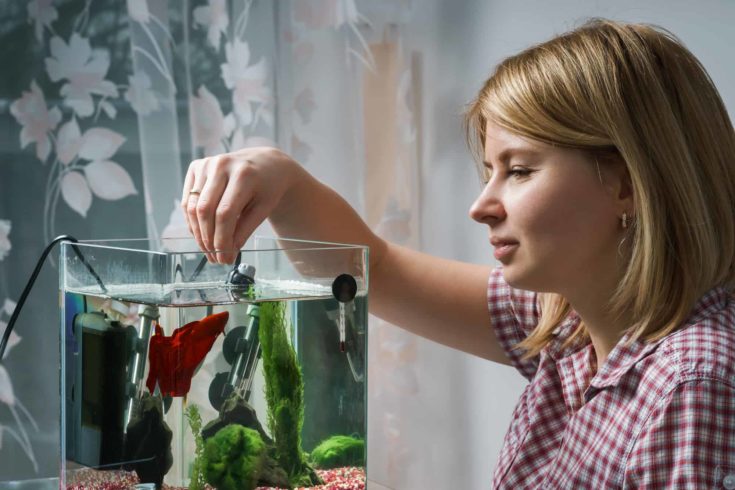
Before you choose a fish tank and bring it home with you, you’ll need to decide where you are going to keep the aquarium in your home. The placement of your tank is all-important, as where you put your aquarium will have a direct impact on the water quality and overall tank conditions. If you get it wrong, the environment could become a stressful and potentially dangerous place for your fish.
When it comes to aquarium placement, there are a few important factors to consider:
Weight Of The Tank
Where you put your fish tank will, to a large extent, be determined by its size and weight. As a general rule of thumb, you should never put an aquarium greater than 10 gallons on a desktop or a piece of regular furniture, as the weight is simply too great.
The empty weight of most aquariums will appear in the manufacturer’s overall specification details. However, you need to know what the tank will weigh when it’s full of water, substrate, and decorations. Most medium and large aquariums can be purchased with a cabinet that’s been specifically constructed to hold the tank when it’s full of water.
Never put a fish tank on a piece of standard household furniture. Regular furniture is not built to take that amount of weight and may collapse under the strain. Even small, desktop tanks can be extremely heavy when fully set up, so it’s crucial that you know how to calculate the total weight of the tank and its contents before you buy.
Full Tank Weight Calculation

- First, you need to know the size of your fish tank in terms of gallons.
- Second, you need to check the product specification to determine the actual weight of the tank when it’s empty.
- Now, multiply the gallon capacity by 8.34. That’s the weight of water per gallon in pounds.
- Take that figure and add the empty weight of the tank to it.
The final figure you end up with is the weight of the tank when it’s full of water.
Add The Weight Of The Substrate
Of course, you will be adding a substrate to the aquarium. Check the weight of each bag of the substrate and add that figure to the weight of the empty tank plus water.
The final number that you arrive at is roughly the total weight of the aquarium, plus substrate, plus water.
Now that you know how much the aquarium will weigh when full of water, decorations, and fish, you can check that where you intend to place it will take the weight.
Other Considerations
There are many other factors to take into account when deciding where you’re going to put your tank.
Maintenance Access
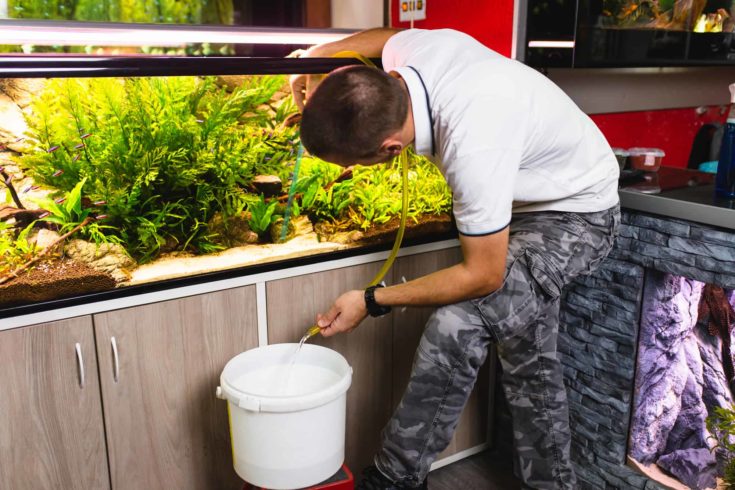
Although it may be tempting to squeeze your new tank into a small alcove or push it right back against a wall in your living room, don’t forget that you will need access to the aquarium for maintenance. Also, all fish tanks need ventilation space around them to prevent condensation from forming that could cause mold and mildew to grow on walls and other adjacent surfaces.
Tropical, marine, and coldwater tanks all need a power supply for heaters, filtration systems, lighting units, etc. Make sure that you have easy access to sufficient power points, and remember that you will need enough space to get to external sumps and filters to carry out routine maintenance.
You will also need to get to the inside of the tank to carry out water changes, prune your plants, and clean the aquarium glass, so make sure that you have enough space above the tank to allow you to lift the lid.
Is The Floor Level?
A fish tank full of water that is set on a cabinet or stand will become unstable if you place it on an area of flooring that’s unlevel. Unlevel flooring beneath the tank will make it impossible to fill the tank properly, and it could even tip right over.
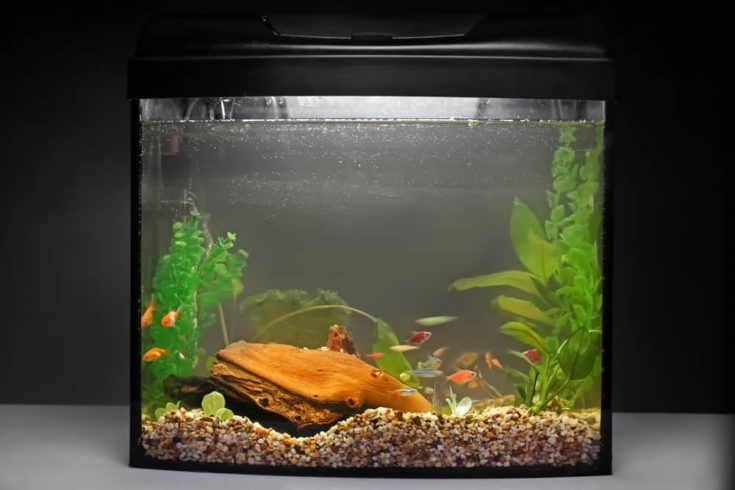
Also, although there is a degree of flexibility within the aquarium sealant, if the flooring beneath the setup is uneven, additional stress will be placed on joints and seals, potentially causing the aquarium to leak.
Health and Safety
As mentioned earlier, you’ll need to plug filters, lighting units, etc. into electricity power points. Ideally, these should be beside or behind the tank cabinet or stand where you can reach them. If at all possible, avoid trailing cables that could present a tripping hazard, or cover them with a cable mat if necessary.
Power strips should be at least a foot away from the aquarium or set on the wall above and behind the tank in case of accidents or water leaks.
Remember that you will need to carry out partial water changes every week or two. So, if possible, place the tank as close to a water source as possible.
Water Temperature
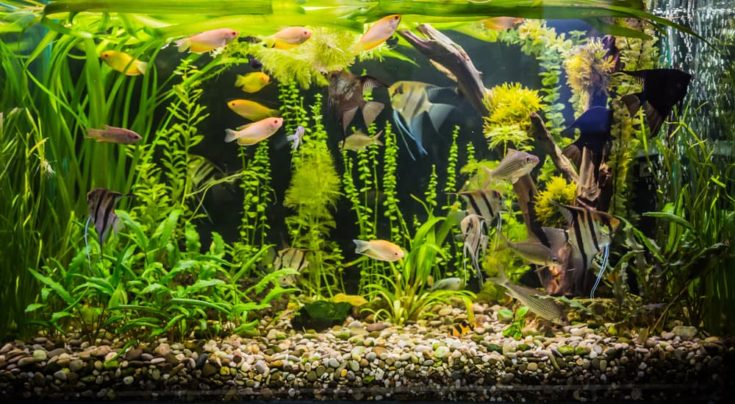
Most species of tropical fish are sensitive to extremes of high and low water temperatures. For that reason, never put an aquarium right next to a fireplace, radiator, heater, or air conditioning unit. Similarly, draughts can chill parts of the tank, leaving fish vulnerable to temperature shock, which can kill. So, don’t place your tank where it will be exposed to the breeze blowing through an open window.
Direct sunlight shining into a tank can create hotspots that could harm your fish and play havoc with your heater thermostat. Also, excessive amounts of natural light will cause algae to bloom, making a mess of your decorations and the tank glass. So, don’t put your tank near a window or directly underneath a skylight or Velux window.
Visibility VS. Safety
If you’re going to spend much time and expense on creating a beautifully aquascaped tank full of a community of brightly colored, thriving fish, you want to put it somewhere it can be enjoyed by your family and friends. For example, I have one of my tanks tucked neatly into an alcove in my living room, where it can be viewed and enjoyed but isn’t in the way.
Keep in mind safety as well as visibility. It’s not a good idea to put your fish tank in a doorway or high traffic area where it could be knocked over by a running child or boisterous dog. Also, don’t put the tank right behind a door where it could cause an obstruction and get knocked each time the door is opened.
Good Vibrations?

Did you know that water transmits shockwaves much more efficiently than air does?
That’s why many experienced aquarists agree that the vibrations that subwoofer speakers cause travel through the water in a tank that’s placed adjacent to a sound system. Those vibrations stress your fish in the same way that someone tapping on the aquarium glass does. That unobtrusive tapping may sound like nothing on the outside of the glass, but inside the tank, the noise is comparable to that of a muscle car’s engine at maximum revs in your living room!
If you have shy fish species in your collection, they’ll soon disappear every time you put your stereo system on, leaving you looking at a deserted tank. So, the quieter the location that you choose for your aquarium, the better your fish will like it.
At The Edge
If you know that the floor of the room is made from solid concrete or stone, you could opt to have the aquarium in the center of a large room.
However, it is usually better to put your tank close to a wall or in a corner of the room. If your floor is built on rafters or you want to keep the tank upstairs, the floor is often weaker in the center, as it’s not as well supported.
Feng Shui Aquariums
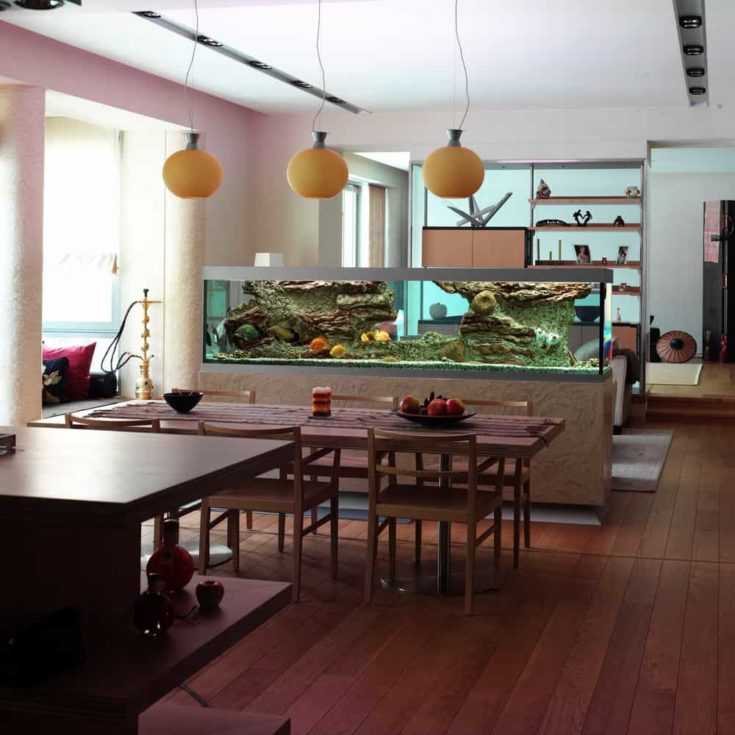
Have you ever seen an aquarium in a Chinese restaurant or bank? If you did, that’s because a Feng shui aquarium is regarded as a potent charm for abundance and wealth. Provided that the tank is placed as per Feng shui guidelines and is kept well-maintained, it will bring the energy of abundance to the space it inhabits.
Also, a fish tank contains the harmonious balance of each of the five Feng shui elements:
- Water: The water contained in the tank
- Wood: Represented by live plants and driftwood
- Metal: Part of the structure of the tank
- Earth: The substrate, rocks, and pebbles
- Fire: The tank lighting and brightly colored fish
A good balance of these elements is thought to attract good Feng shui energy to a room.
Feng Shui Fishes
Certain fish species are associated with Feng shui aquariums. The most famous of these is the Dragonfish or Arowana, which represents wealth. These fish are aggressive and rapid growers, symbolizing abundance, and power.
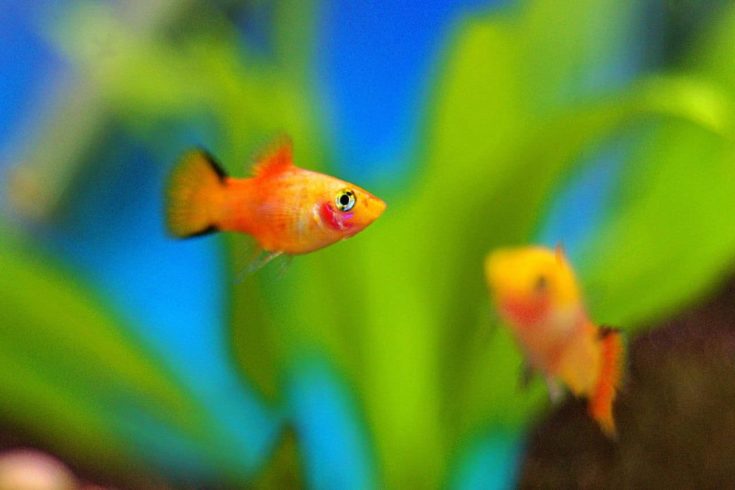
If you don’t have room in your tank for one of these giants, you might prefer to keep goldfish. You can choose from many bright colors and keep groups of fish, representing abundance, in relatively small tanks.
Nine is the preferred number of fish to keep in your tank, according to Feng shui guidelines. One solitary fish is not considered ideal, as that doesn’t indicate abundance.
Where To Place Your Feng Shui Aquarium
According to Feng shui, the best location for your fish tank is in the southeast corner of your room. That’s also referred to as the “Feng shui wealth and abundance Bagua area.” That part of your space typically carries the best energy that will enhance prosperity and wealth, encompassing those wealth-related remedies that can boost Feng shui energy.
Alternatively, you could place your Feng shui aquarium in the northern part of your space. That area is regarded as the career Bagua area, and there’s also the eastern part of your house space that’s known as the health and family Bagua area.
Where Not To Place Your Feng Shui Aquarium

Feng shui principles say that you shouldn’t place your fish tank in a bedroom. That’s because the aquarium’s vibrancy and energy may damage the calming vibe that you want in a bedroom, potentially disrupting sleep and causing the occupant unnecessary stress.
You should also avoid placing your Feng shui fish tank in a kitchen. It’s believed that the water element creates a direct conflict with the powerful fire element of cooking in the kitchen.
Types Of Feng Shui Aquarium
As well as the placement of the Feng shui aquarium, it’s essential to choose the correct type of tank if you want to attract the best energy. That means that the tank must work with the Feng shui element that’s associated with the area in which you place it.
So, if you want to keep the aquarium in your money space that’s governed by the wood element, you should pick a rectangular tank, which is the shape associated with that element. Alternatively, choose a square tank that’s linked to the earth element, which nourishes the wood.
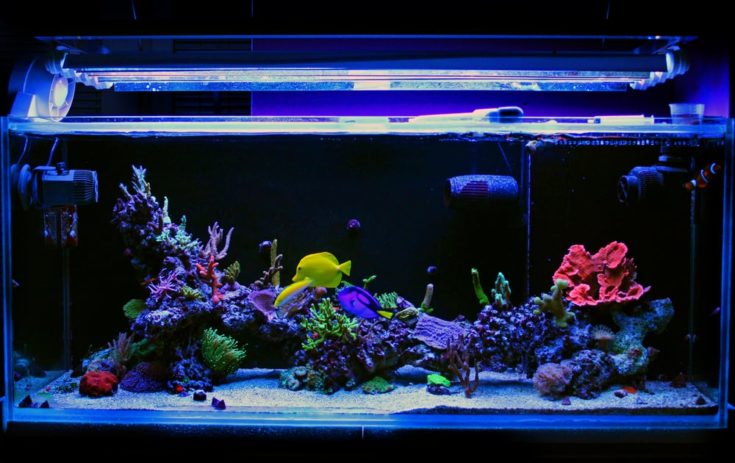
If you fancy a round, fish bowl-shaped tank, choose a small aquarium for your money space. That’s because the round shape is linked to the metal element, and the presence of the metal element can reduce the energy of the money area’s wood element.
In Conclusion
I hope you enjoyed my guide on what’s the best place to put your fish tank.
Essentially, you need to site your tank where it won’t be exposed to extremes of hot and cold that could be harmful to your fish. Also, you should make sure that the tank is in a space that’s easily accessible for general maintenance tasks and within safe and easy reach of an accessible power source.
If you have any questions or comments about where to keep your fish tank, please use the comments box below. And do like and share our article if you found it helpful.

Is a Blue light or white tank top light better forFreshwater tropical and plant aquarium?? Thanks
Hi Donna
A combination of blue and white light is fine for a planted tank. Different plant species need different amounts of light to thrive, so you need to check what plants you have and do some research to find out if they’re high, medium, or low light species. You can read more about lighting options for your tank in this article.
Hope that helps!
Alison Page
Site author
Thank you for all the information its really helpful to me cause im planning tohavean aquarium
Ima water sign and i want to place it between our living room and dining area